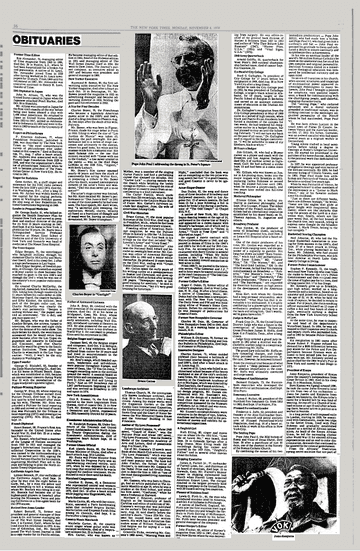Getting an obituary in the New York Times is about the best posthumous status symbol there is. It connotes having lived a significant, important life. There are at least three books that reprint or examine these obituaries.
But what about the paid obituaries, the death notices in a tiny font adjacent to the stories of the famous dead? Who appears there and why? I tracked all of the paid notices for 2016 and calculated the top ten people cited. While fame may help one rise to the top of the paid obituaries, it may be generosity—of money and spirit—that makes a bigger difference.
The bulk of the paid notices come from three categories: the person’s employer, organizations that he or she worked with, and his or her family and friends. Some people have only one announcement. Others have a few that trickle in over a few days, often with an increase on Sundays. Those who made it into 2016’s top ten all had 19 or more.
On the one hand, these notices are democratizing. Anyone can submit one about anyone who has died. On the other hand, the notices veer in certain directions. Most people featured currently live—or once lived—in the New York City area. And it is hard to place a notice if you do not have a lot of money. The cost is over $50 per line, and each line has only 28 characters. As a result, the paid obituaries are often placed by well-off New Yorkers about well-off New Yorkers.
Fame alone does not assure a major presence. For example, Morley Safer, the veteran 60 Minutes correspondent who lived in New York City, got only four notices when he died in May. Legendary boxer Muhammad Ali, who died in June, had only two despite the worldwide adulation that accompanied his passing. Astronaut John Glenn, admittedly an Ohioan, had only one paid notice in December.
So who made the top ten? Being well-known did not hurt. The brilliant chronicler of the Holocaust and other instances of human suffering, Elie Wiesel, was second with 40 notices after his July death. Of course, Wiesel was also involved with numerous non-profit and charitable organizations—such as Yeshiva University, the American Jewish World Service and even the Friars Club—many of which contributed a condolence note. “S’iz gefain a demb,” read one note in Yiddish. “We have lost a great man.”
Another famous decedent was Judith S. Kaye, the pioneering judge who presided over New York’s Court of Appeals for nearly 16 years. Kaye’s 32 notices, all in January, ranked her third and one of two women, the other being the interior decorator Gail Maidman, to land in the top ten. “Extraordinary jurist, humanitarian, friend,” wrote one admirer of Kaye.
James M. Nederlander, the Broadway impresario who died in July, was also a household name—at least to fans of the theater. Less well-known were Martin Begun, active in both real estate and health care; Robert Kaufman, a Manhattan real estate executive and philanthropist; Norman Peck, former managing director of the Carlyle Hotel and benefactor to cultural and medical institutions in New York City; Jerome Siegel, a Westchester industrialist active in the Democratic Party and many New York charities, including Big Brothers/Big Sisters; and Joseph Wilf, a real estate executive and Holocaust survivor who gave to Jewish causes. “With his life,” one mourner wrote, “he made my own so much more meaningful.”
Number one by a mile was another enormous figure in New York real estate, Jack Rudin, who died in December at the age of 92. I counted 91 paid death notices for Rudin, more than double that of Wiesel.
The main reason for this outpouring of sympathy? The May and Samuel Rudin Family Foundation, founded by Rudin’s parents, has donated millions of dollars to educational, medical, humanitarian and other ventures. I should know. When I was a young faculty member at the Columbia College of Physicians and Surgeons, the Rudin Foundation funded a program I started in which internal medicine residents presented complicated ethical cases to their peers and medical students discussed situations where they had felt uncomfortable on the wards.
President George H.W. Bush was often ridiculed for his 1988 phrase “1,000 points of light,” which celebrated America’s community organizations. But reading the paid notices, and the profuse thanks offered by organizations and individuals, underscores the impact that generous and important people may have on the lives of others. A full-page obituary may catch the eye first, but the notices may tell the real story of a life.
First published on www.forbes.com on January 5, 2017.
